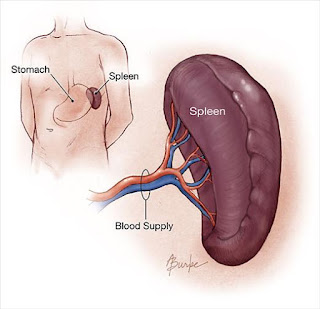Selasa, 07 Juli 2015
The Spleen
The Spleen
This leaflet gives a brief overview of the spleen and its functions.
What is the spleen?
The spleen is an organ about the size of a clenched fist found on the left-hand side of your upper abdomen. Its main functions are to filter your blood, create new blood cells and store platelets. It is also a key part of your body's immune system.
Where is the spleen found?
The spleen is found on the left side of your body, behind the stomach on a level with the 9th to 11th ribs. It is similar in structure to a lymph node, and is the largest lymphatic organ in the body. The spleen contains two main types of tissue - white pulp and red pulp. White pulp is lymphatic tissue (material which is part of the immune system) mainly made up of white blood cells. Red pulp is made up of venous sinuses (blood-filled cavities) and splenic cords. Splenic cords are special tissues which contain different types of red and white blood cells.
What does the spleen do?
Blood flows into the spleen where it enters the white pulp. Here, white blood cells called B and T cells screen the blood flowing through. T cells help to recognise invading pathogens (germs - for example, bacteria and viruses) that might cause illness and then attack them. B cells make antibodies that help to stop infections from taking hold.
Blood also enters red pulp. Red pulp has three main functions:
1.It removes old and damaged red blood cells. Red blood cells have a lifespan of about 120 days. After this time they stop carrying oxygen effectively. Special cells called macrophages break down these old red blood cells. Haemoglobin (a chemical which carries oxygen) found within the cells is also broken down and then recycled.
2.Red pulp also stores up to one third of the body's supply of platelets. Platelets are fragments of cells circulating in the bloodstream that help to stop bleeding when we cut ourselves. These extra stored platelets can be released from the spleen if severe bleeding occurs.
3.In fetuses (unborn babies) red pulp can also act like bone marrow, producing new red blood cells. Usually this stops after birth, but may start again in some people with certain diseases.
While the spleen performs a number of important functions, it is not essential to life. Other organs such as the liver and bone marrow are able to take over many of its jobs. Your spleen may be removed (splenectomy) for various reasons - for example, because of an illness that affects the spleen, or if it is damaged by an injury. Also, the spleen may not work well in some diseases - for example, sickle cell disease, thalassaemia, and lymphomas.
However, people who have had their spleen removed are more likely to get infections and may be put on long-term antibiotics to prevent this. See separate leaflet called Preventing Infection after Splenectomy or if you do not have a Working Spleen for further detail.
Langganan:
Posting Komentar
(
Atom
)






Tidak ada komentar :
Posting Komentar